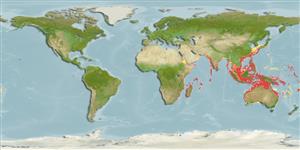Common names from other countries
Environment: milieu / climate zone / depth range / distribution range
Ecologie
Rifbewoner; diepteverspreiding 10 - 100 m (Ref. 349). Tropical
Indo-West Pacific: including the Persian Gulf, to Melanesia; north to Japan and south to Queensland.
Length at first maturity / Size / Gewicht / Leeftijd
Maturity: Lm ? range ? - ? cm Max length : 9.5 cm SHL mannelijk/geslacht niet bekend; (Ref. 349); common length : 6.0 cm SHL mannelijk/geslacht niet bekend; (Ref. 349)
Locally consumed by fishermen and used for shellcraft. Commonly trawled offshore in the tropical West Pacific (Ref. 349). Found offshore (Ref. 799). In general, members of the family Personidae are carnivores (Ref. 67623). A specialist feeder on chaetopterid polychaetes (Ref. 128693).
Life cycle and mating behavior
Geslachtsrijpheid | Voortplanting | Kuitschieten | Eieren | Fecundity | Larven
Members of the order Neotaenioglossa are mostly gonochoric and broadcast spawners. Life cycle: Embryos develop into planktonic trocophore larvae and later into juvenile veligers before becoming fully grown adults.
Poutiers, J.M. 1998. (Ref. 349)
Status op de Rode Lijst van het IUCN (Ref. 130435)
Status bij CITES (Ref. 108899)
Not Evaluated
Not Evaluated
Gevaarlijk voor mensen
Harmless
Gebruik door de mens
| FishSource |
Tools
Meer informatie
Leeftijd/GrootteGroeiLengte-gewicht parametersLengte-lengte parametersMorfologieLarvenAbundantie
Internet-bronnen
Estimates based on models
Preferred temperature
(Ref.
115969): 24.3 - 29, mean 28 (based on 1344 cells).
Kwetsbaarheid
Low vulnerability (10 of 100).
Prijsklasse
Unknown.
